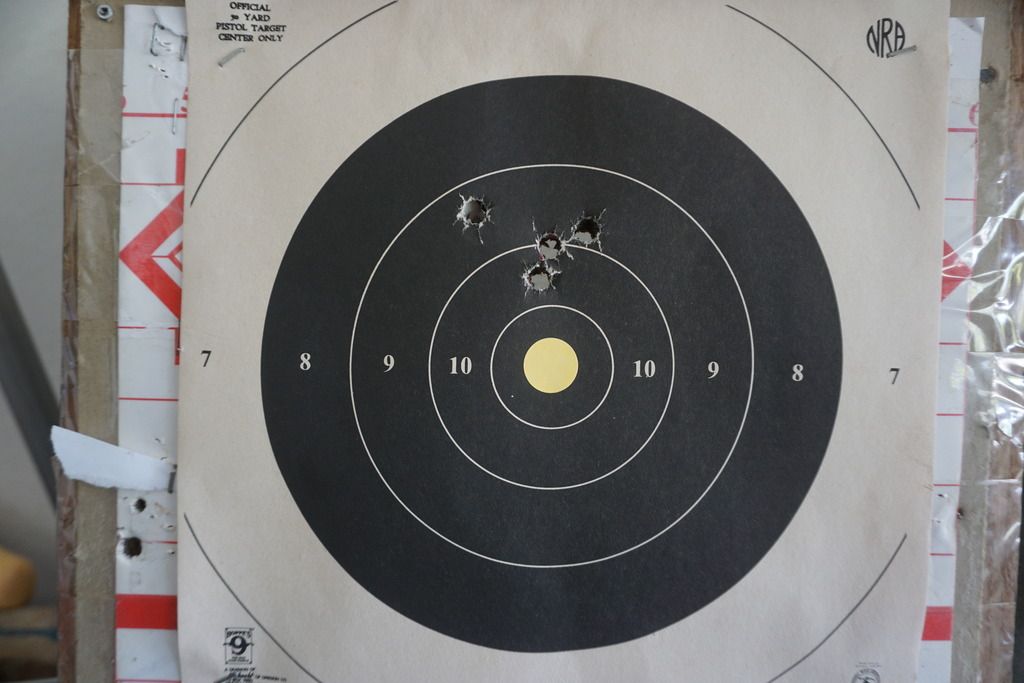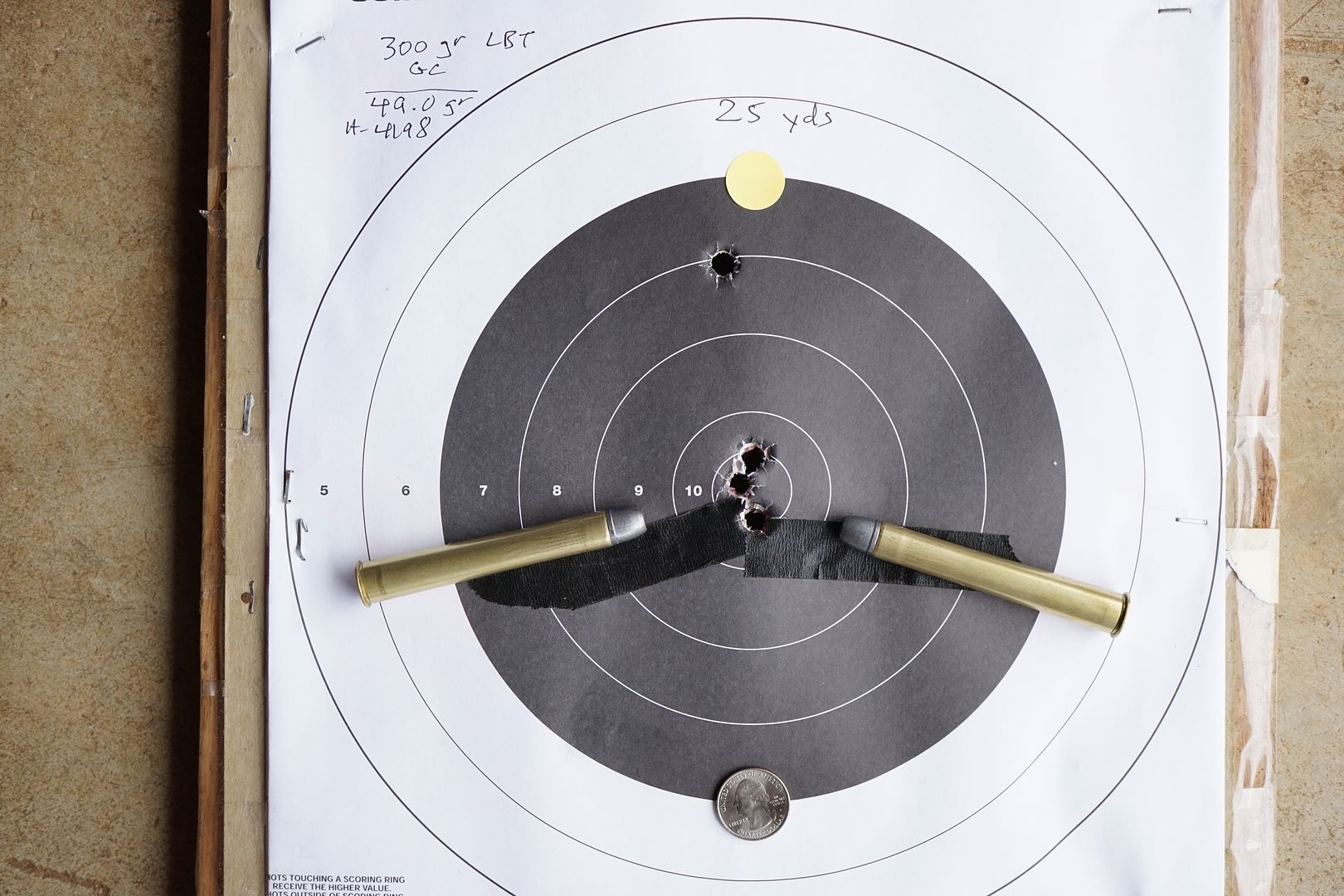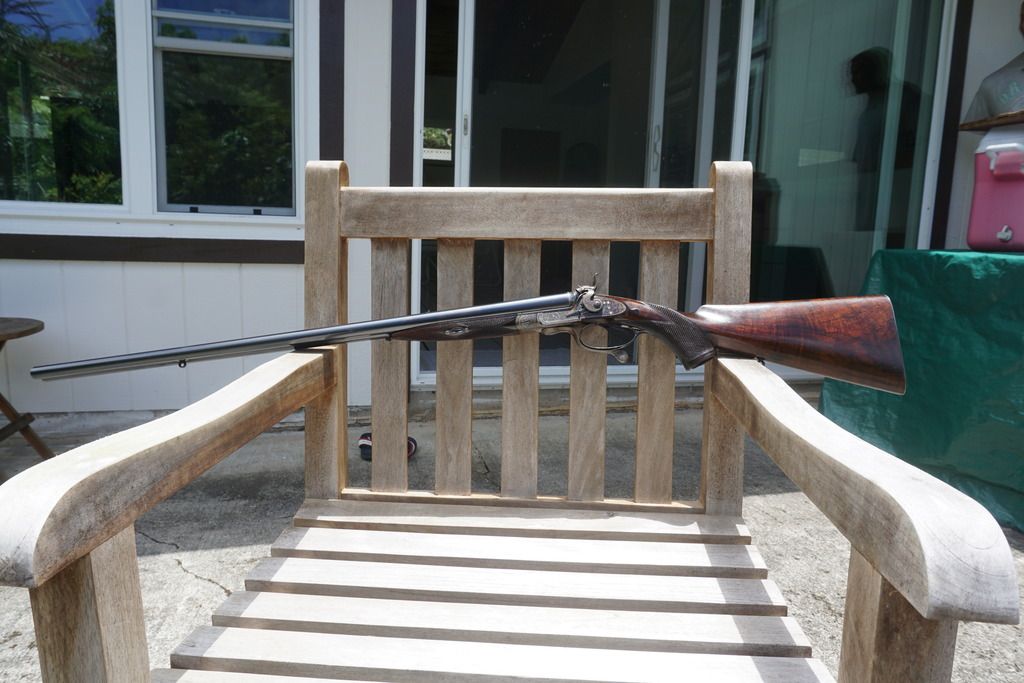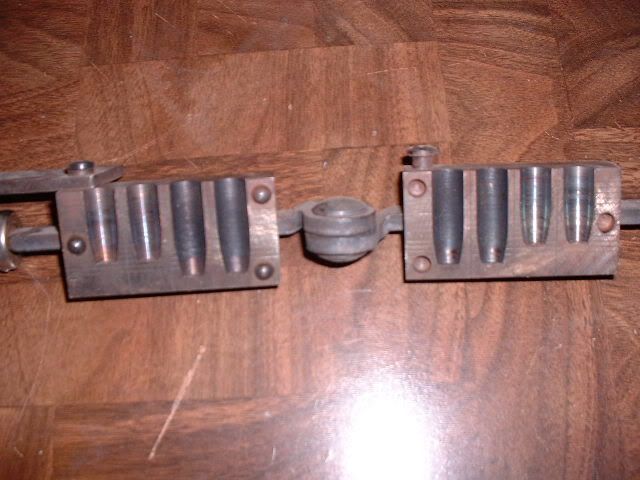| pamtnman |
| (.275 member) |
| 27/10/16 02:27 PM |
|
|
Hi folks. I'm a new guy on this forum. Glad to be here. Working on loads for a .450 BPE, and looking for original moulds, reloading equipment. I figure the original tools would provide strong hints about correct components, eg bullet diameter & style. Thank you!
| Rockdoc |
| (.400 member) |
| 27/10/16 09:36 PM |
|
|
Welcome!
Can't help with your quest!
Cheers, Chris
| Postman |
| (.375 member) |
| 28/10/16 01:26 AM |
|
|
Welcome to the forum!!! If you haven't already done so, pick up a copy of Graeme Wright's "Shooting the British Double Rifle".... Are you shooting a double or single shot? Presumably the single shot is a piece of cake to get a consistent load and is not terribly fussy about bullet shape compared to a double where regulation is the key factor to consider.
| pamtnman |
| (.275 member) |
| 28/10/16 02:08 AM |
|
|
Thank you, Postman! I do have the third edition of Wright's book. It is helpful, and the fourth edition should have information about how sights were used in the 1870s-1900 vs today. There's clearly a difference but I'm not yet in that groove. More information about moulds, lead alloys, paper patching, and gunsmiths capable of helping. Both doubles and singles are in my arsenal. Right now I'm working on a Charles Lancaster oval bore .450 SxS. What would really help is to have an original Lancaster.450 bullet mould, or get some bullets cast from one. I've been experimenting with .452, .453, .456, .457, .458....all paper patched. One thing the wright book helps me understand is the idea of relative accuracy, though when this gun is just right, it is incredibly accurate. Getting a load that is consistent is the challenge.
| Huvius |
| (.416 member) |
| 28/10/16 03:27 AM |

|
|
|
What size bullet is working the best?
Are you using Black or a NfB load? I'm thinking a big bore oval bore gun must use Black Powder to work well.
I wasn't aware that Lancaster made a mold specially for an oval bore gun.
| DarylS |
| (.700 member) |
| 28/10/16 03:37 AM |

|
|
|
Interesting thread - keep 'er going.
Welcome pamtnman.
| pamtnman |
| (.275 member) |
| 28/10/16 04:27 AM |
|
|
I've shot cast 350 grain (345-351) bullets in .452, .456, .457, and swaged in .458. Everything is paper patched. I've learned it requires two wraps, not one. Patching paper thickness varies with the bullet diameter. Still testing how far over bore to go, .001-.003".
The .452 patched to .461-.462 has done pretty well. The .457 Gould has done well. N for B mostly, using Ross's 40% rule. Started at 42 grains 4198, worked down, now working up and back around 42-43.
Olde Eynsford 1.5 was mediocre alone and as a duplex load.
Yes, Charles Lancaster made his / their own loading tools and bullet molds. Not specific to the oval bore, as they were in the .450 BPE class and shootable by just about any .450 BPE, but the exact diameter they used is what I'm after. Not mentioned in the 1889 Lancaster catalogue or in his shooting book. At the 1862 military shooting trials (Westley Richards, Alexander Henry, Charles Lancaster... The three great firearms minds of that time...why hasn't anyone done a movie about this?), the Lancaster ovals were shooting .442 diameter bullets, patched up to fit in a nominal bore diameter of .456. How much patching, using which "prepared paper," to what final diameter, I can't determine.
| pamtnman |
| (.275 member) |
| 28/10/16 04:32 AM |
|
|
I should say that I use a Lee sizing die to take the .456 and .457 cast bullets down to .452.
| OahuKaneohe |
| (.275 member) |
| 28/10/16 04:45 AM |
|
|
I have 4 and my shooting friend has 2 450 BPE 3 1/4" case double rifles. All 6 guns have enfield or standard rifling and we use commercially cast .459" 300-325 grain GC bullets. We follow Wright's suggestions on page 219 of his third edition data with Kynoch foam filler wads to keep the powder against the primers.
I have chronoed these loads at speeds up to 2000 f/s.
A 1869 Rigby hammer double shot great 25 yard target, held center. Lighter load of 45 grains 4198 and 325 grain bullets. About 1900 f/s at 19.5K pressure.

A 1890 Holland double, first shot held center, hit high next three held on the quarter hits all centered. About 2000 f/s at 23.1K pressure per Sherman Bell's testing.

Get a hold of Sherman Bell's articles "Finding out for myself" that pressure tests factory NFB loads
at 25K pressure and reloads using 4198, RE 7, 3031, and 4064. He tested the factory 120 grains of
BP loads at 21.6K pressure. And his article on use of 14 types of case fillers used in NFB loads.
The Rigby:

The Holland:

| Huvius |
| (.416 member) |
| 28/10/16 04:48 AM |

|
|
|
Have you tried a patched bullet sized to slip fit into a fired case? I think you will find that with a NfB load that will be best. Sounds like you are pretty much there with your .461-.462" bullets and it sounds like that is the best performer so far.
| pamtnman |
| (.275 member) |
| 28/10/16 05:18 AM |
|
|
Hey Oahu. Nice guns. Very accurate shooting. Thanks for the response. These Lancaster smooth oval bores are in their own world. Normal rules do not apply. Paper patching is a must. N for B does --NOT-- give the bullet rear-end that "bump up to bore size" that black powder does. Sherman Bell's articles are fascinating, as are Ross's, and I have benefited tremendously from them. The Lancaster catalogues call for a 350-grain bullet and "about" 100 grains of black powder for his 1880s .450 BPE. This gun was made in 1888, and the ledger loading instructions clearly state two wraps of paper and 100 grains of powder. Adding complexity is the bore's taper and gain twist. It is a real project. Hang in the Ten Ring, man! :-)
Huvius, that's excellent advice. Last week was the first time I started doing that, and there's no column in my data tabs to account for it. The challenge with that slight fit is this is a hunting gun, and loose hand-fitted bullets are not practical in the field. Whatever load works best, assuming at least one is finally, consistently good enough at 100 yards, will be my hunting load. Winter in Pennsylvania is pretty harsh. Bullets have to survive in that environment.
Edit: Oahu, all of my loaded cases are filled to the top with Dacron, covered by a .060" fiber wad, on which the patched bullet is seated.
| OahuKaneohe |
| (.275 member) |
| 28/10/16 06:28 AM |
|
|
I am having some problems loading a 303 with Metford rifling, kind of an oval bore of sorts. A seated cast lead .3135 bullet has to jump 3.50" to hit the rifling. I may try BP to "bump" up the
base to a larger diameter and therefor hit the rifling earlier.
Right now my cast bullet loads "key hole", but jacketed .312 Woodies don't, but has to jump to 3.8"
to hit the rifling.
| pamtnman |
| (.275 member) |
| 28/10/16 06:52 AM |
|
|
Oahu, try paper patching a bullet that is .004-.006 below bore/rifling diameter. Get the package .001"-.002" above bore/rifling diameter. That at least gets the bore filled and the projectile gripping the bore. I use lead in the range of BH 7-9, which involves the unscientific method of melting chunks of sheet lead and adding wheel weights for tin to get the complete fill of the mold. I now use a lead hardness tester, which confirmed as OK my past hillbilly approach to pouring lead projectiles.
These guns were made to shoot paper patched bullets. Black powder can "bump up" the heel, but I've learned that more than anything youve got to fill the bore.
| pamtnman |
| (.275 member) |
| 28/10/16 07:09 AM |
|
|
I tried and failed to edit that response. The BH 7-9 I get from my lead mixes range in alloy from 50:1 to 20:1, all soft enough to conform to the -tapered- bore and not damage it. As the taper gets smaller, the patched bullet is increasingly swaged down to fit. Too hard a bullet can damage the barrel in this environment. Soft lead is the way to go.
| DarylS |
| (.700 member) |
| 29/10/16 05:55 AM |

|
|
|
Love that Rigby. The "Holland" is OK too - lol.

Undersized smooth sided bullets, paper-patched UP to bore diameter and used with a full case black powder is what got my brothers Sharps and my Rolling Block's 3 1/4" ctgs. shooting well.
Of course, smokeless powders probably won't do this.
| pamtnman |
| (.275 member) |
| 29/10/16 06:08 AM |
|
|
Thank you, Daryl. That is useful. Pretty sure the Black Powder Express bullets were grease grooved. The Holland mould design shows multiple ridges facing forward to hold the paper against the bore. In this Lancaster tapered oval bore, the grease grooves serve the purpose of allowing the bullet to "give" and a place for the moved lead to go as it swages down the bore. A solid bullet could fit well near the chamber, but end up busting the muzzle on exit. Creating lots of margin for safely fitting to the bores and muzzles is how this gun is coming back to life. Also, the barrels are thin on these doubles, not nearly as strong as the heavier single shots. Boy would I like to see a Lancaster .450 BPE mould. Especially for the 1880s. Probably looks a lot like the "Gould" hollowpoint. The Lyman mould for this bullet casts a .457 grease groove bullet.
| Huvius |
| (.416 member) |
| 29/10/16 07:44 AM |

|
|
|
pamtnman, the Holland and Holland bullets were, afaik, meant to be greased instead of paper patched. H&H was pretty early in supplanting the PP bullet with GG bullets.
I don't think there is much worry in shooting a smooth sided solid PP bullet made of any reasonably soft lead alloy as the taper is so gradual.
I'm pretty sure the topic of the Lancaster oval bore was discussed somewhere along the line and the minor and major diameters were not too great, maybe a few thou I think.
A chamber cast will reveal a lot in this case. For sure, the case neck and bullet will be perfectly round. The leade will be interesting to see as to how it transitions from round to oval.
Also, eventhough the bore is oval, you can still use a pin gauge to measure the minor diameter and to measure any taper the bore may have.
| DarylS |
| (.700 member) |
| 29/10/16 08:56 AM |

|
|
|
I have a set of these Mitutoyu Telescoping gauges, code # 155-903. The measure from 5/16" (about 8mm) up to 6" with the 6 piece set. Nice to have.
https://www.amazon.ca/Mitutoyo-155-903-Piece-Telescoping-Gage/dp/B001OBV1Y8
I thought I had a set of these too, but could not find them.
Maybe my bro has those.
https://www.amazon.ca/Mitutoyo-154-901-P...PY6PWWQAY2XPXNM
| pamtnman |
| (.275 member) |
| 29/10/16 09:28 AM |
|
|
Thanks, Huvius. Good suggestions and observations. These barrels were slugged. Cerrosafe is sitting here waiting to be used, just have not gotten to it yet. Two inches below the chamber the bore is .465 average between the high and low measurements. The muzzles average (Rule of Halves) .461. The leade is fascinating, because there is no real distinct chamber. Rather, the barrel ovals just kind of blend and fade up into the chamber area. Fired case mouths are not perfectly round. The chamber area is very generously sized. Rounds kind of dangle in there. Not a tight fit by any definition.
I have yet to find a Lancaster oval bore discussion on line that is satisfactory for anyone, especially the original poster. These are tough guns to master, unless you already have the cased tools or the original shells. Few were made. Lancaster calls for these bullets to get two wraps of paper. Bullet sits over millboard and greased cloth, then 100 grains of Curtiss & Harvey's #6. Perhaps this gun did use a smooth bullet. I would use it in a heartbeat, if I knew what it was. But I am afraid of damaging the gun, so grooved bullets are what I use, so they can really move around and absorb all the swaging that goes on through the bore. I am open to all ideas.
CptCurl
|
| (.450 member) |
| 29/10/16 09:41 PM |

|
|
|
I am confident that the Lancaster oval bore rifles generally used paper patched bullets. I believe you are worried about a non-issue. Your more troublesome question is what weight bullet to use to achieve regulation.
If you have a smooth sided bullet of 20:1 alloy and of a diameter equal to or only slightly less (a thousandth or so) than the "land" diameter of your rifle - the smallest dimension an inch or so ahead of the chamber, this should work correctly. Then you experiment with paper thicknesses, starting with onion skin, and working with thicker papers (if necessary) until you get a perfect seal of the gases. You can determine this by inspection of the patch fragments found ahead of your shooting bench.
This process sorts out your bullet diameter and patch thickness. Beyond that, your loading questions will be what weight bullet and what sort of wad column to use.
Powder is an important consideration. Many shooters are finding success using GEOX Olde Eynsford 1-1/2 F in black powder cartridge rifles. It seems to approximate Curtis & Harvey's #6. Our member, Mike Rowe, is having perfect success loading his Watson .450 3-1/4" BPE double with this powder and PP bullets. Perhaps he will chime in. He wins matches with his rifle and loads. I know, as I have competed against him.
A grease groove bullet might ultimately work in your Lancaster, but it would not be my first choice.
I'll say one last thing about your barrel taper. There's nothing unusual about that. My Henry rifles all have taper; at least as much as yours. There's no question they were intended for smooth sided paper patched bullets, as I have the original moulds, numbered to the rifles. The bullet and patch get a grip to start with, making a perfect gas seal just as they enter the barrel, and they maintain a tight grip and seal all the way down the barrel. Don't worry about the taper. My damascus barrels aren't troubled by it.
And by the way, welcome to the NE forums!
Curl
| pamtnman |
| (.275 member) |
| 30/10/16 11:23 AM |
|
|
Thank you, CaptCurl. That is interesting information. I am mulling it over.
The 1880s Lancaster .450 BPEs all shot paper patched 350-grain bullets with "about" 100 grains of powder. The catalogues all say this, and my reading of the original Lancaster ledgers revealed nothing new, unfortunately.
The instructions for this particular individual gun say two wraps of paper and 100 grains of powder with millboard and greased cloth. Nothing said about the bullet style, although the 1889 Lancaster catalogue says different bullet styles can be accommodated. A picture of the bullets they used, or of a contemporaneous Lancaster mold, would help settle this.
My understanding is most if not nearly all BPE rifles were tapered, as is this one (it has gain twist, too). What is different here is the smooth bore. It is cavernous. Filling it correctly is a challenge. Tomorrow I am shooting three NFB loads with a .452 diameter soft lead grooved bullet patched up to .463.
Some of the larger diameter bullets patched with 9# paper left lead at the muzzles, with NFB. Black powder did not leave leading, interestingly. Makes me wonder if the bullet heel did bump up. If so, it did not improve accuracy...
The Olde Eynsford 1.5 did not perform well in this rifle, neither at 100 grains nor as a duplex of 85 grains OE over 5 grains 4198 as a priming charge. The duplex load did shoot cleaner and with about half of the wonderful flame. Going to try WLMR primers with Olde Eynsford, probably closer to the large Berdan primers they had back then.
I may try a smooth sided bullet so long as it is .008 or so smaller than the bore average, and can be patched up with 16# paper to .462. That way I have confidence it won't stress the bore too much.
Again, thank you for the advice.
PA
| pamtnman |
| (.275 member) |
| 04/11/16 10:07 AM |
|
|
NFB with patched GG bullets got 2.5" groups at 50 yards, 4" groups at 70 yards. In a few days I will be shooting three select loads at 100 yards, and hoping for 6-8" groups, although I believe this gun can do better. An adjustable mold for a smooth-sided paper patch bullet is in the works, thanks to the advice I have received here. Next run of BP loads will have the bullets sizer-crimped, because there were some low-pressure problems with the hand-fit BP loads.
| Huvius |
| (.416 member) |
| 04/11/16 10:59 AM |

|
|
|
Quote:
NFB with patched GG bullets got 2.5" groups at 50 yards, 4" groups at 70 yards.
Are those composite groups from both barrels or individual groups from each barrel?
| pamtnman |
| (.275 member) |
| 04/11/16 12:58 PM |
|
|
composite groups from both barrels. Edit: Two of the 70-yard groups were actually about 2.5", with one "flyer" each, the flyer being relative to the other three hits. and the flyers were not too bad, but they increased a 2.5" group to 4". This is why the gun can probably do a lot better. The problem is probably due to my paper patches, which are neolithic cro magnon man quality. up next are gentle case sizer-die crimps and my best-ever paper patches.
| pamtnman |
| (.275 member) |
| 17/11/16 02:33 PM |
|
|
Well, loads that did very well at 50 and 70 yards were disastrous at 100 yards.
| DarylS |
| (.700 member) |
| 17/11/16 02:43 PM |

|
|
|
We had a Sharps 3-1/4" that would not shoot anything but
masking tape wrapped 400gr. PURE lead bullets. Go figure.
I guess what I am saying is straight paper is not the only thing you can patch with.
Mine, however, loved the 580gr. PURE lead conicals, 2-wraps
of .003" bond paper, with it's 18" twist - the longer bullet pictured in the above mould picture.
| aromakr |
| (.375 member) |
| 19/11/16 03:12 AM |
|
|
Have you tried a Sharps type bullet? Smooth sided with a hollow base. I spent many years shooting original Sharps riles, with bullets designed from original sharps moulds. using pure lead and two wraps of high rag content paper we had excellent results for accuracy, using ffg black with a priming charge of IMR 4759. I don't off hand remember the bullet diameter to bore dia. but using the combination mentioned the bullet upset well, but keep in mind the Sharps barrel's groves were only about .003 deep
Bob
| DarylS |
| (.700 member) |
| 19/11/16 05:09 AM |

|
|
|
After patching, the bullets were .451" - thus .438" to .439" prior to patching.
Patched, if pushed through the bore (easily pushed), would show marks from the lands.
Upon firing, they would slug up to fill the rifling.
This technique is covered in Paul Mathews book - "The Paper Jacket".
| pamtnman |
| (.275 member) |
| 10/04/17 02:49 PM |
|
|
months later: tons of experimenting, jiggering moulds, getting custom moulds by Leo Bumphrey, etc the gun shoots half-inch groups at 100 yards, 4 inches high. So it is probably dead on at 150 yards. It was made for shooting red deer in NW Scotland, where long shots were usual, so it appears it is dead on after all that time. Thank you for all the advice, guys.
| pamtnman |
| (.275 member) |
| 08/03/18 03:11 PM |
|
|
Quote:
Have you tried a Sharps type bullet? Smooth sided with a hollow base. I spent many years shooting original Sharps riles, with bullets designed from original sharps moulds. using pure lead and two wraps of high rag content paper we had excellent results for accuracy, using ffg black with a priming charge of IMR 4759. I don't off hand remember the bullet diameter to bore dia. but using the combination mentioned the bullet upset well, but keep in mind the Sharps barrel's groves were only about .003 deep
Bob
Thank you for the suggestion. I did try hollow base bullets, and they keyholed. This gun wants plain base, smooth sided paper patch bullets.
| bouldersmith |
| (.375 member) |
| 10/03/18 04:06 AM |
|
|
Pamtnman: Well tell us what you did to get it to shoot such tight groups. Inquiring minds want to know.
OahuKaneohe: Looks like that Rigby found the right home. Glad to see you putting it to use.
| pamtnman |
| (.275 member) |
| 28/03/18 03:00 PM |
|
|
Hey Boulder! Did you order the DGJ winter 2017 edition? Also, this next edition, due out any day, has the final recipe in it, although a big chunk of text was misplaced during the editing and it will go in the next DGJ. Basically use a .450" smooth paper patched bullet patched up to .460", the 40% Ross Seyfried formula with 4198.